These vegan coconut macaroons are sweet, chewy, and tender in the middle with a lightly toasted, crisp shell and optional chocolate topping. Even better, these egg-free macaroons are also gluten-free, dairy-free, optionally sugar-free/ keto/paleo, and require just 7 simple ingredients!
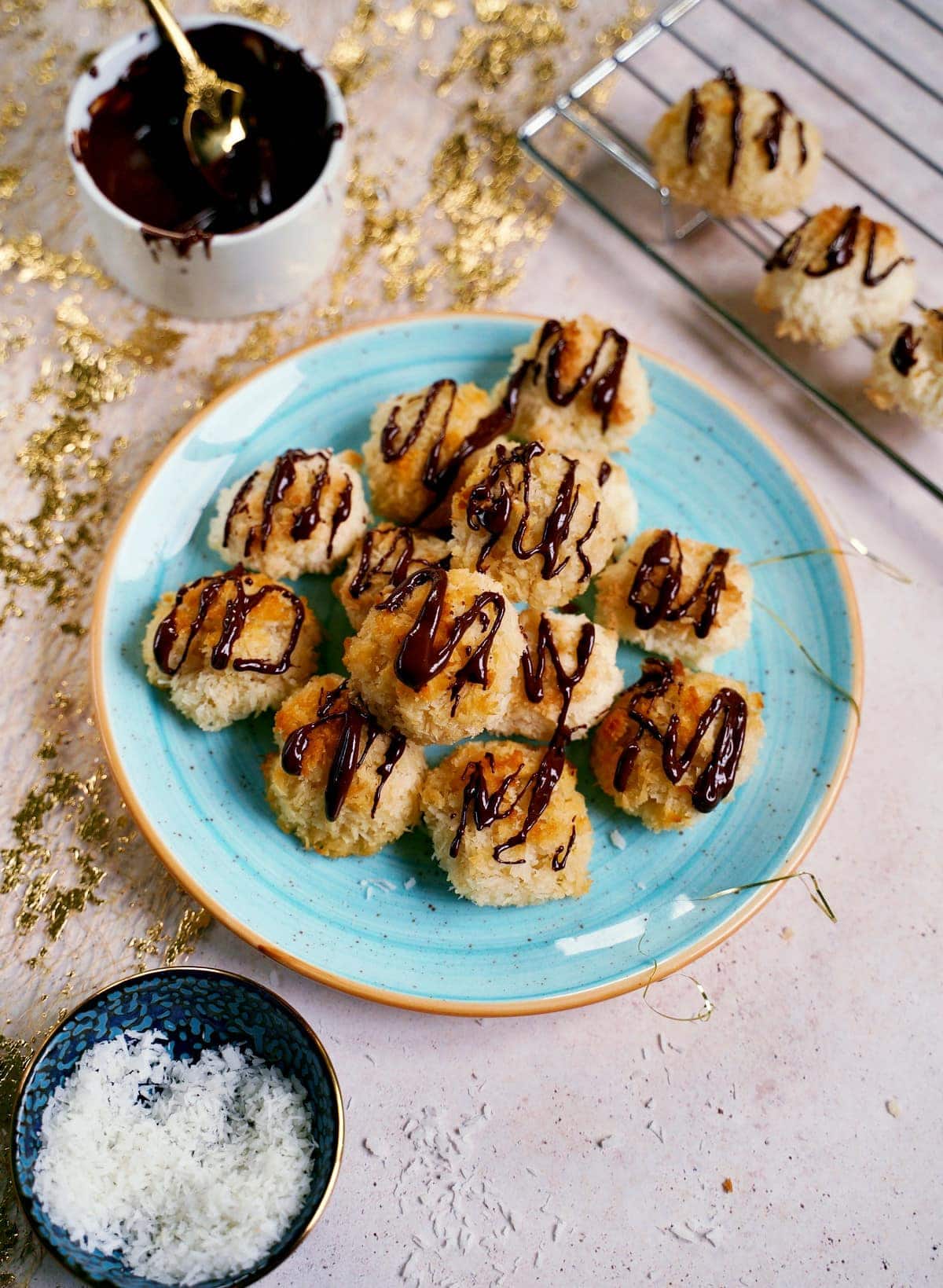
Soft and Chewy Gluten-Free Coconut Macaroons
Whereas regular coconut macaroons are made with condensed milk and eggs, this vegan macaroons’ recipe uses aquafaba (chickpea liquid – also perfect for peanut butter/ strawberry mousse) instead. It also omits the condensed milk entirely for healthier, lower fat, healthy coconut macaroons (there’s even a sugar-free option) that taste just as good as the original, with no chickpea flavor, I promise. And just in time for Christmas!
Plus, this vegan macaroon’s recipe is pretty simple, requiring just one bowl and minimal ingredients, with tons of optional flavor adaptability (my top recommendations are below!). Once baked, they freeze and ship well too, and are perfect for bringing to potlucks, BBQs, picnics, at the holidays (like I’m doing now!), and as a party favor at special occasions.
Want to enjoy more vegan coconut desserts? Check out these 3-ingredient coconut balls, vegan chocolate coconut cups, homemade chocolate coconut bars (Bounty/Mounds), and/or a creamy vegan coconut cake!
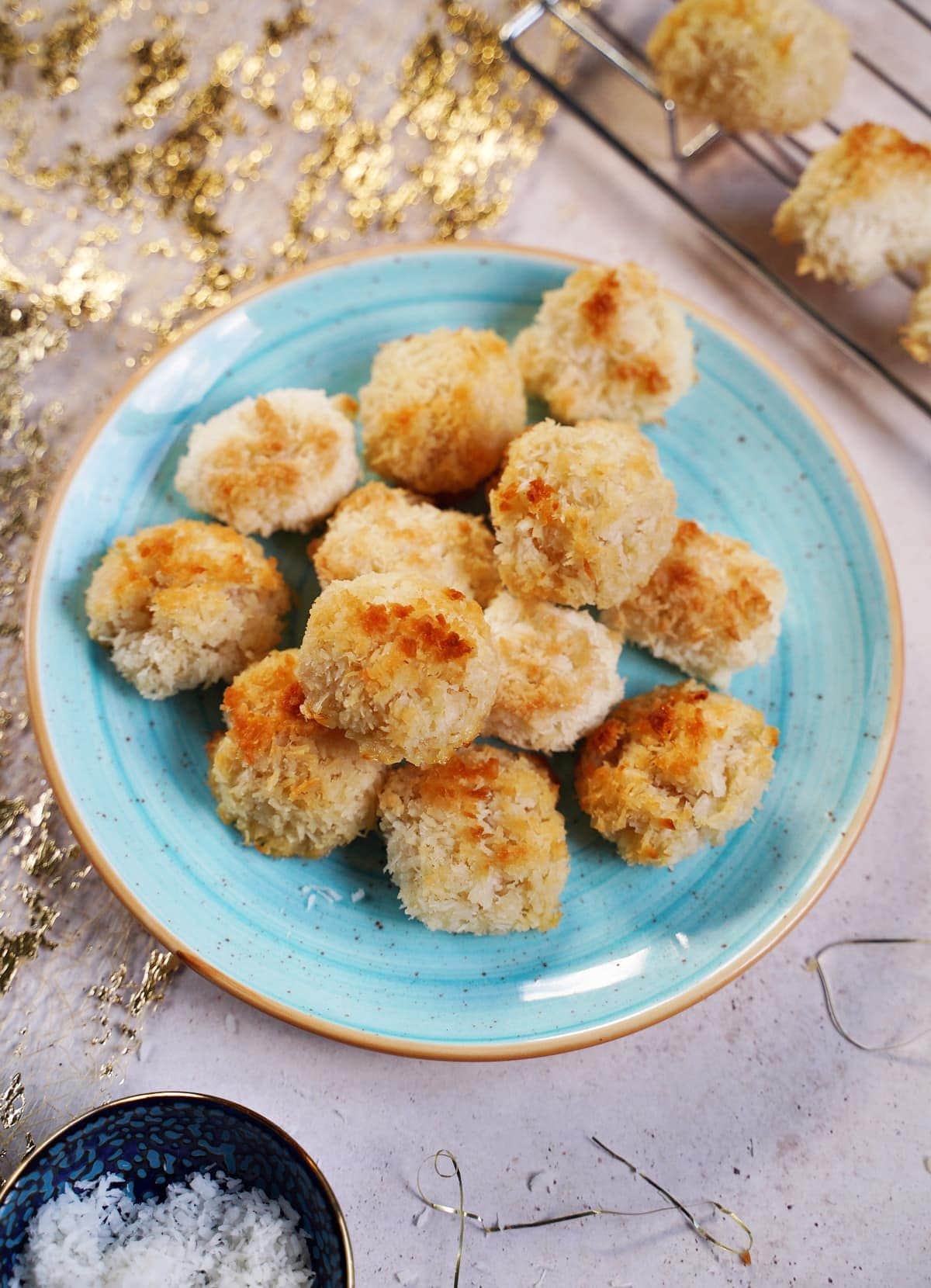
The Ingredients
- Aquafaba: You need the liquid from a can of unsalted chickpeas or from cooking dried chickpeas.
- Cream of tartar: This will help to stabilize the aquafaba meringue, strengthening it and trapping the air better/for longer. It will also take less time to reach the stiff peak phase.
- Citrus juice: You can use lemon or lime juice. I prefer natural juice over bottled.
- Tapioca flour: To thicken/bind and create the correct consistency. Alternatively, you might use arrowroot flour or cornstarch, though I’ve only tried with tapioca flour, so I can’t guarantee results.
- Shredded coconut: Use unsweetened, raw, finely shredded coconut.
- Powdered sugar: Or powdered Erythritol (sugar-free). You could also make your own powdered sugar from unrefined sugars (like coconut sugar) by grinding it in a blender or coffee/spice grinder until powdery.
- Vegan chocolate: (optional) as a dip or drizzle to top the vegan macaroons (like a Mounds bar!). Use a keto/paleo chocolate if preferred. Use white or dark chocolate chips/bar based on personal preference.
Please read the recipe card below for the full ingredients list, measurements, complete recipe method, and nutritional information.
Optional add-ins & Recipe Variations
These vegan, gluten-free coconut macaroons are surprisingly adaptable. Just note that it’s essential to keep the consistency of the batter the same.
- Vanilla extract: A small splash (around ½ tsp) of natural vanilla will add a richer, caramel-y flavor to the aquafaba macaroons.
- Pinch of salt: To help bring out all the flavors in the healthy coconut cookies.
- Cocoa powder: Add 1-2 tbsp cocoa powder. Optionally, add a pinch of instant coffee to enhance the chocolate flavor. Add more (1 tsp+) for mocha macaroons.
- Matcha powder: 1 teaspoon of matcha powder should be enough for delicate vegan matcha coconut macaroons. You could also add matcha if you want to make a white chocolate drizzle.
- Lime/Lemon white chocolate macaroons: Add a teaspoon of zest and a little more fresh juice (or a few drops of lime/lemon extract) to the aquafaba macaroon dough. Then use white chocolate to dip/drizzle.
- Orange cranberry: Add 1 tsp zest with some orange extract (lemon would also work), some spoons of dried cranberries, and drizzle/dip with vegan white chocolate.
- Berry: Experiment with either freeze-dried powder, blending the fruit into the mixture, or a combination of the two.
- Thumbprint macaroons: Make a slight dip in the top of each macaroon and fill with the jam/curd of your choice (after baking). I enjoy using pineapple jam or lime marmalade.
- Dried fruit: cherries, cranberries, finely chopped apricot, blueberries, etc.
- Nuts: Chopped or slivered almonds, crushed walnuts, pecans, etc., for extra flavor/crunch.

How to Make Vegan Coconut Macaroons?
Step 1: Prepare the aquafaba mixture
- First, drain the liquid from a can of unsalted chickpeas into a saucepan and allow it to simmer over medium-low heat until it’s reduced by almost 50% (around 5 minutes). You need around 100 ml of the liquid at the end.
- Once ready, transfer to the fridge or freezer to cool for around 20 minutes.
You can use the leftover chickpeas for other meals like chickpea pasta, crispy chickpeas, or eggplant chickpea curry!
- Once cooled, transfer the aquafaba to a medium-sized bowl along with the cream of tartar and citrus juice. Then, using an electric hand mixer (or perhaps a Kitchen aid), whip it for 3-4 minutes.
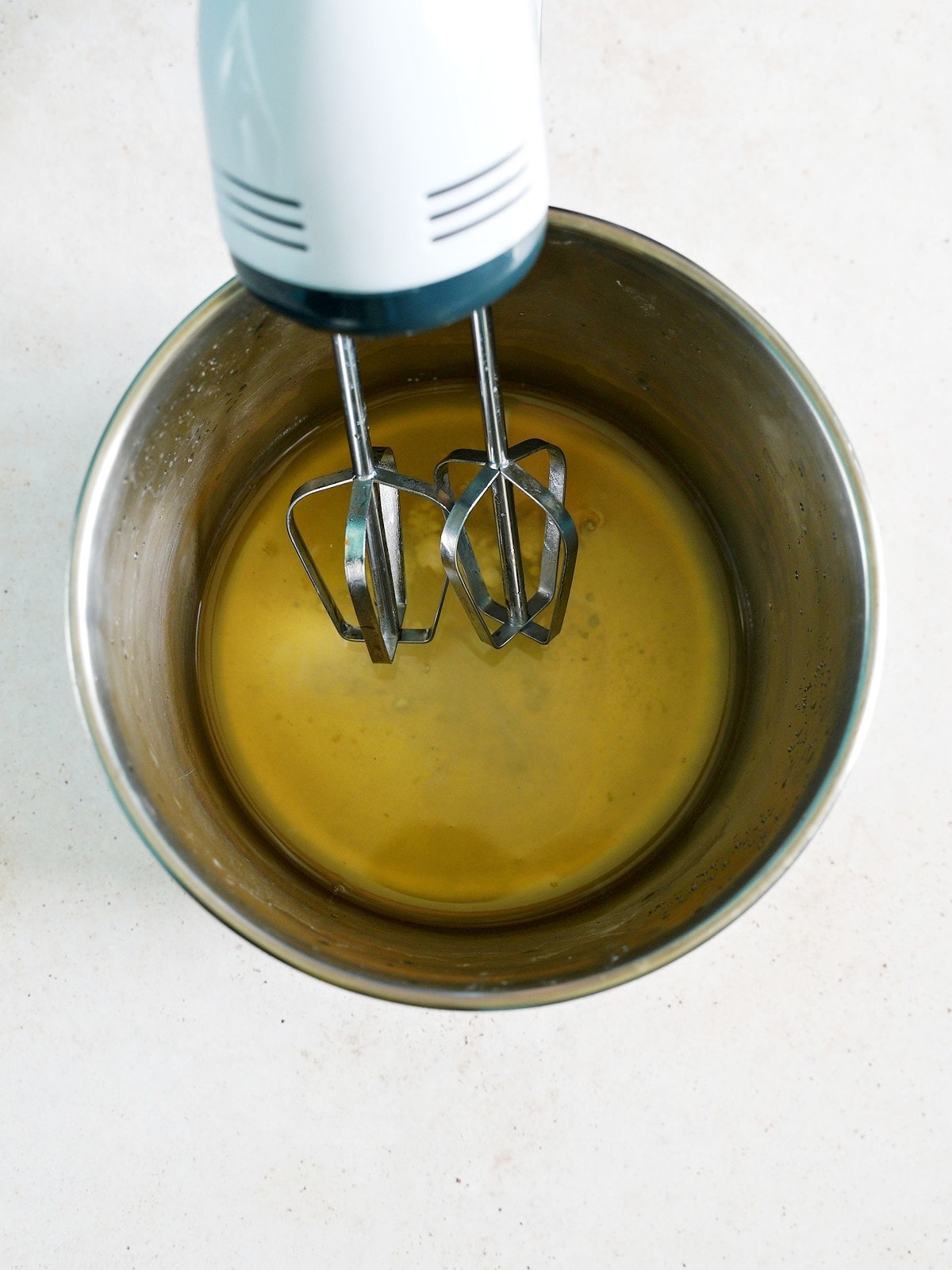
- Add the tapioca flour and whip until there are stiff peaks (a further 3-4 minutes).
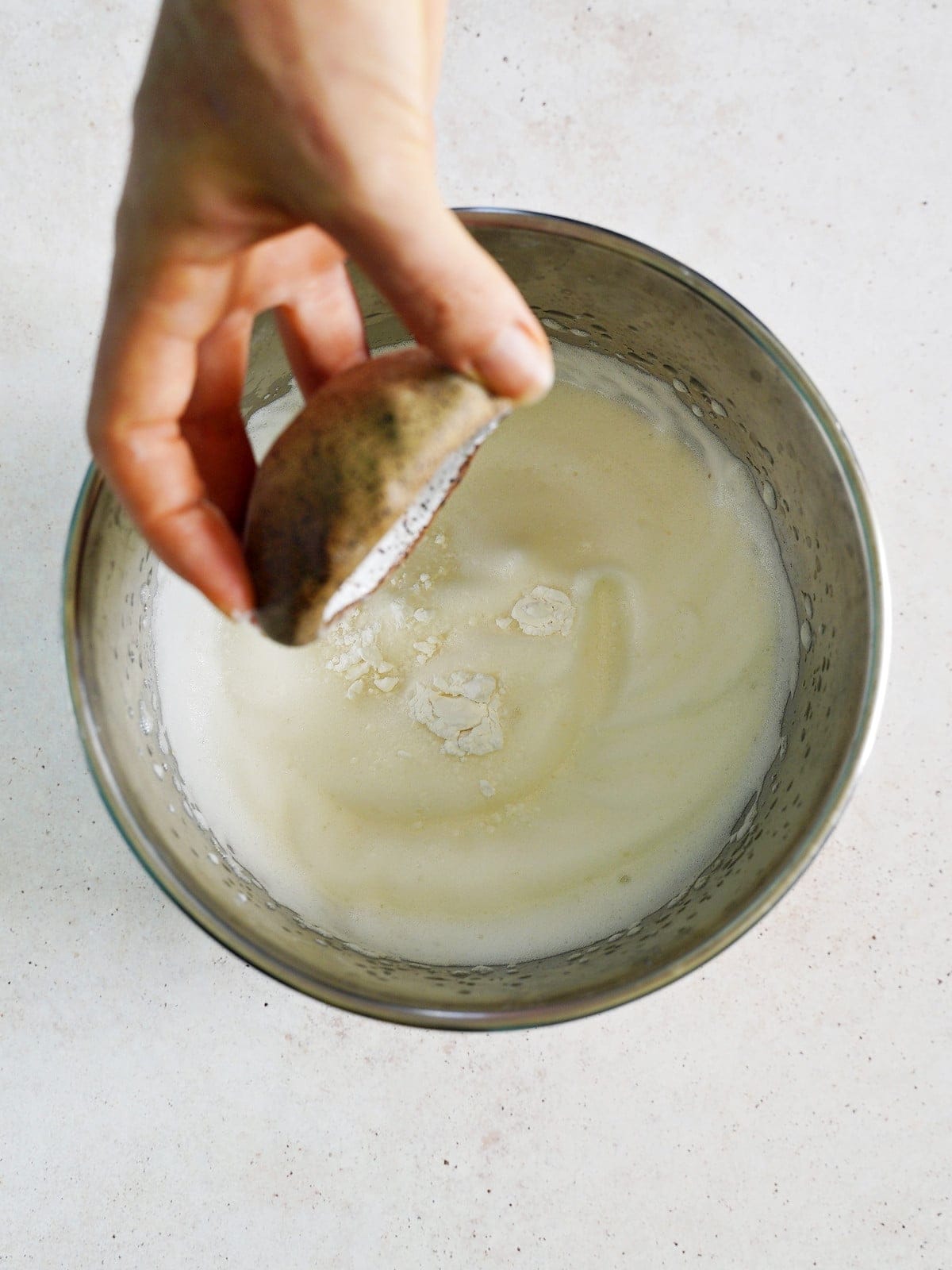
- Then, start adding the powdered sugar, one tablespoon at a time, while whipping. After all the sugar is added, the whipped aquafaba should be glossy, stiff, and able to be turned upside down without falling.
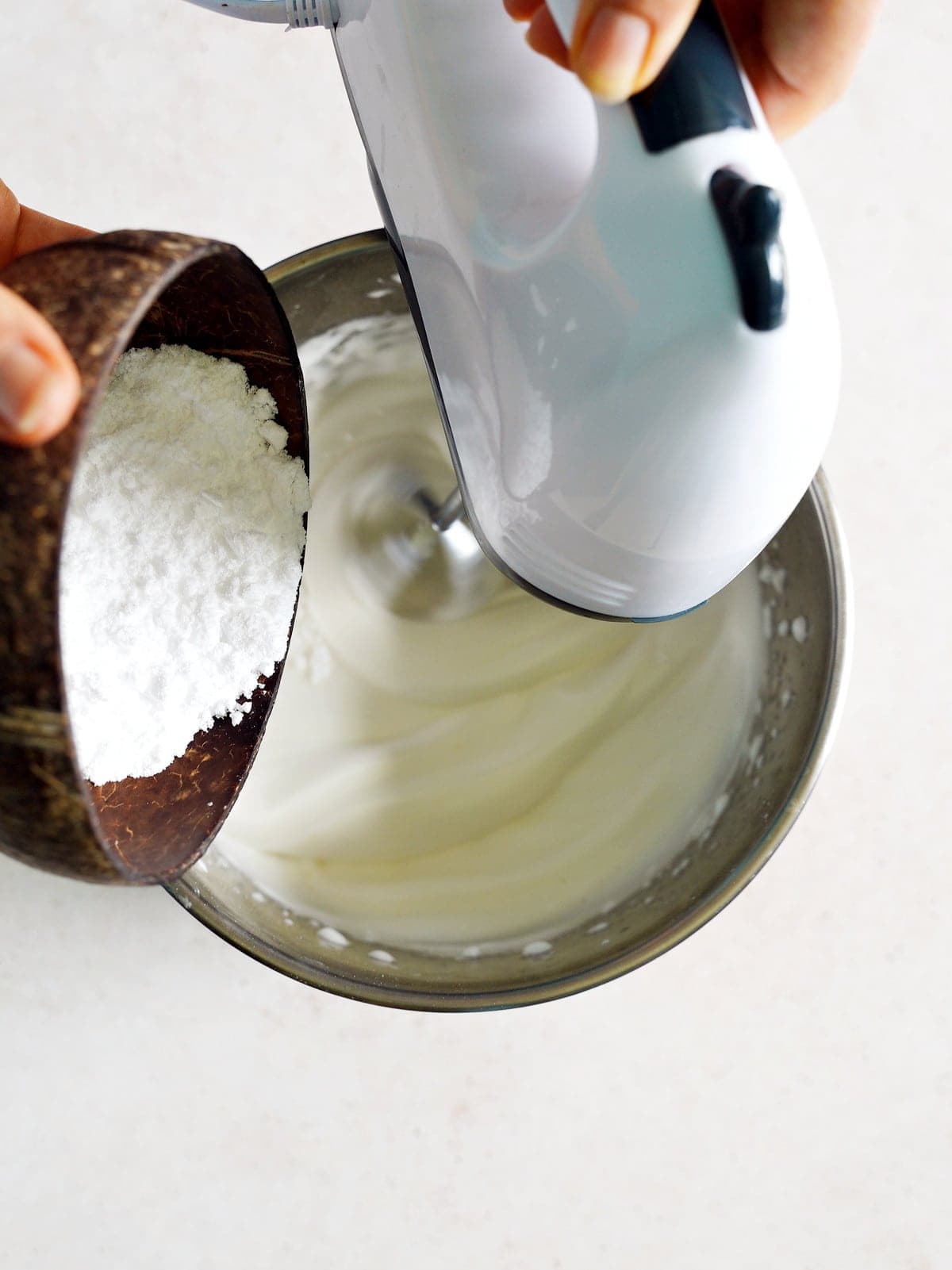
It’s basically impossible to over whip the aquafaba, so do it for as long as needed. 10-15 minutes is usually enough, though.
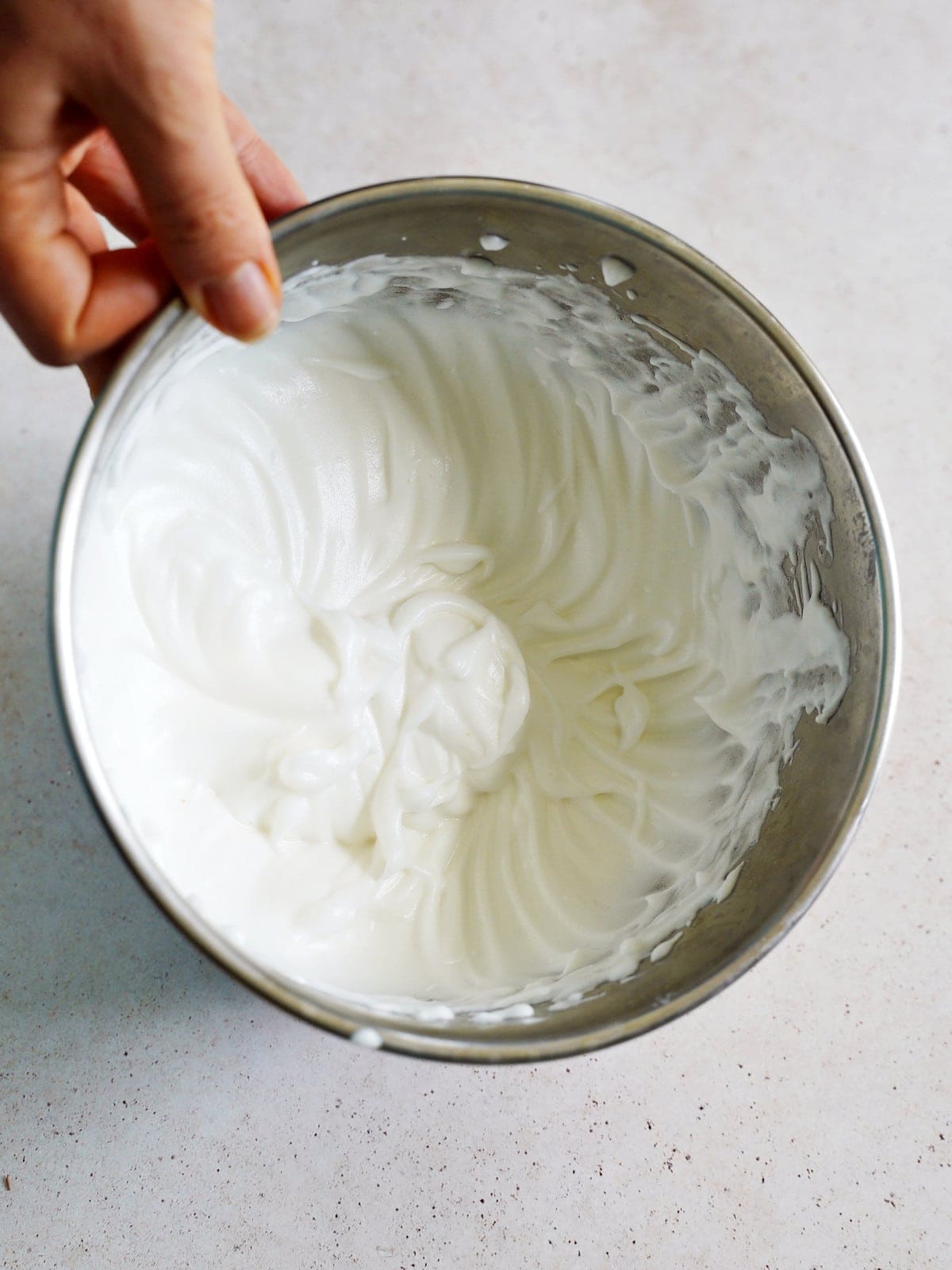
Step 2: Add the remaining ingredients
- Preheat the oven to 300F/150C and line a large baking sheet with parchment paper or a silicone baking mat.
- Next, slowly add the coconut to the aquafaba mixture, one tablespoon at a time. Use a silicone spatula to gently stir/fold it into the mixture and avoid beating out the added air. By the time all the coconut is added, it will have started absorbing the aquafaba mixture. It should be thick and scoopable.
The mixture needs to have the correct consistency, wet but scoopable/not too liquidy. Adding the coconut one tablespoon at a time makes it easy to adjust the amount added.
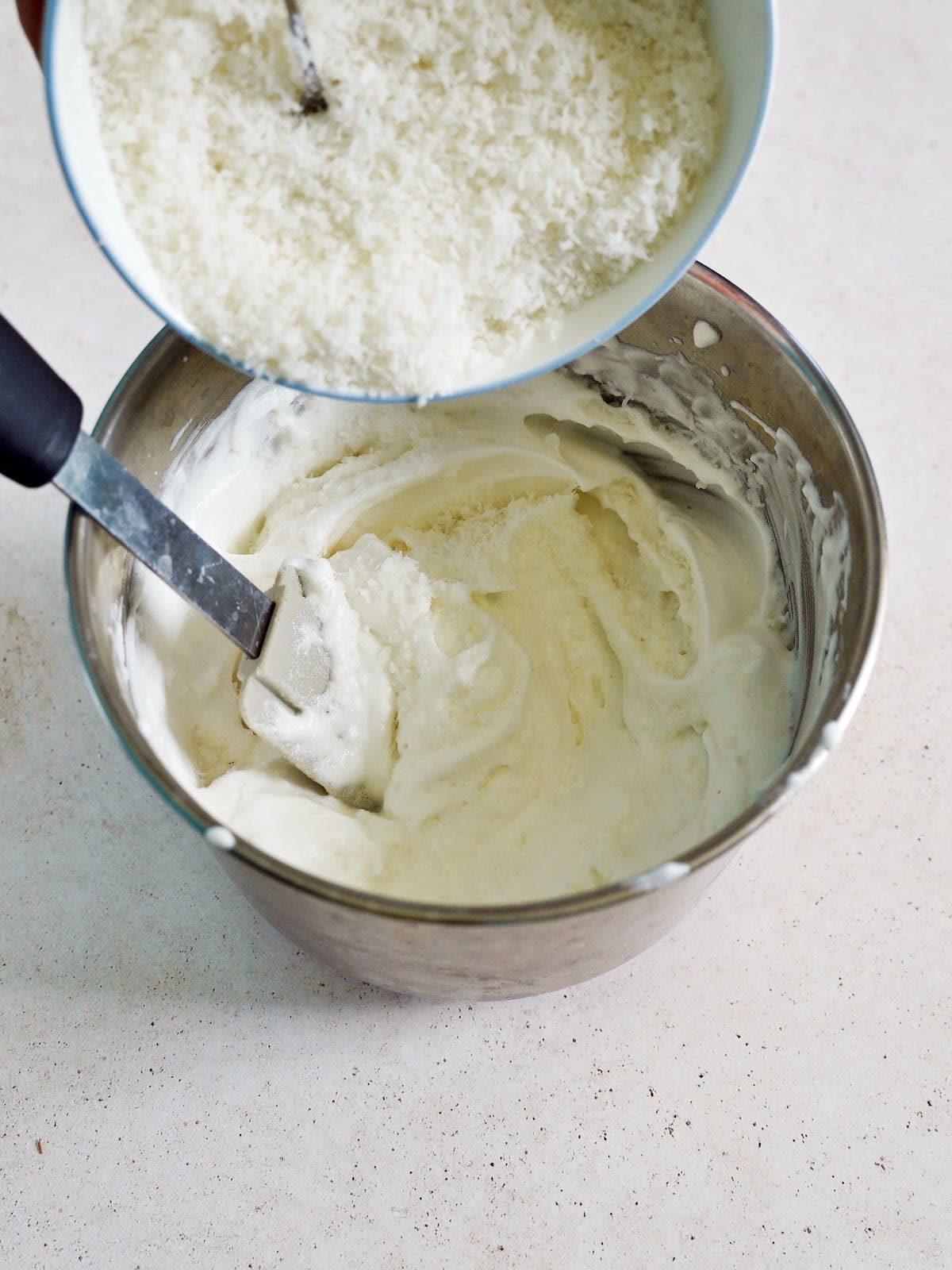
- Then, using heaped teaspoons (or a level tablespoon/ cookie scoop, packed tightly), transfer the mixture to the prepared baking tray, with a bit of space between each one.
- Bake the coconut cookies in the oven for between 30-35, until the tops/edges are golden. Then remove from the oven and cool for at least 10-15 minutes. They will be very fragile while still hot and firm up while cooling. So it’s best to leave them until thoroughly cooled.
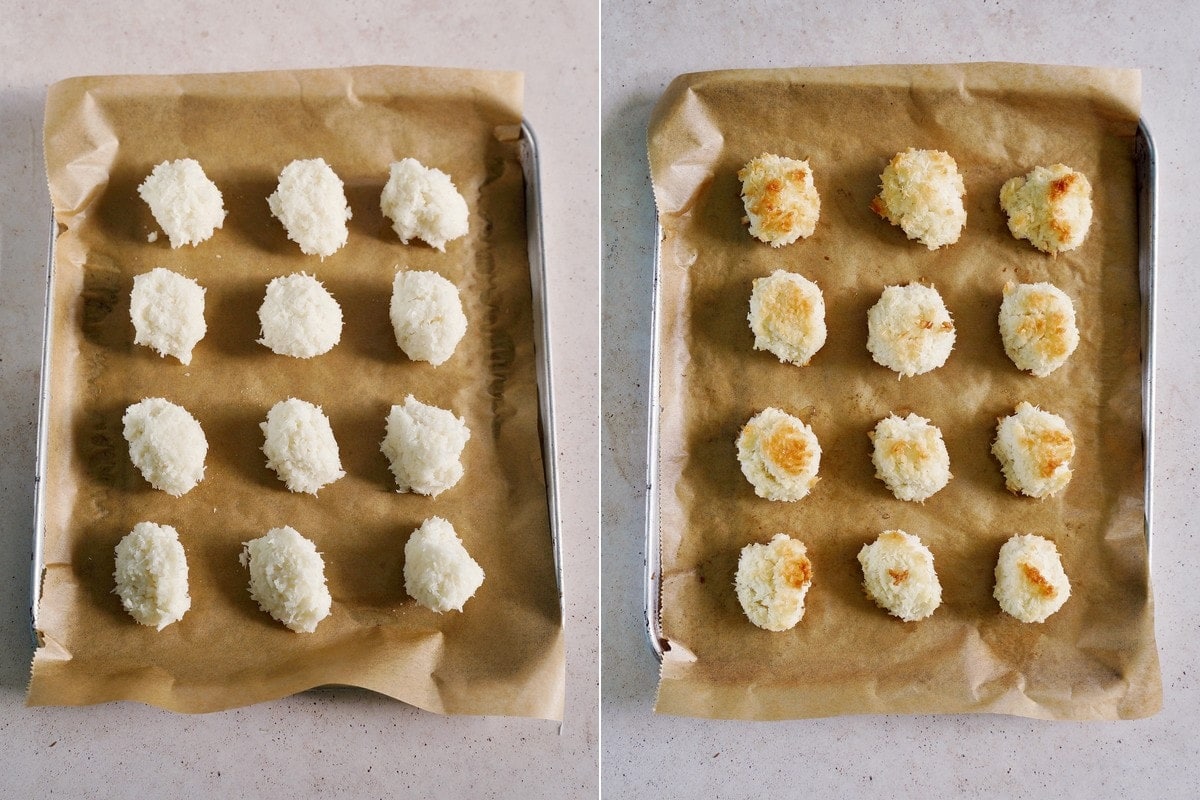
For Chocolate Dipped Macaroons
- Melt some chocolate in either the microwave (15-20 second increments, stirring in-between) or using a double boiler.
- Then dip the bottom of each macaroon into the melted chocolate. Or use a spoon/ piping bag to drizzle over the top.
- Chill the vegan coconut macaroons for several minutes to set.
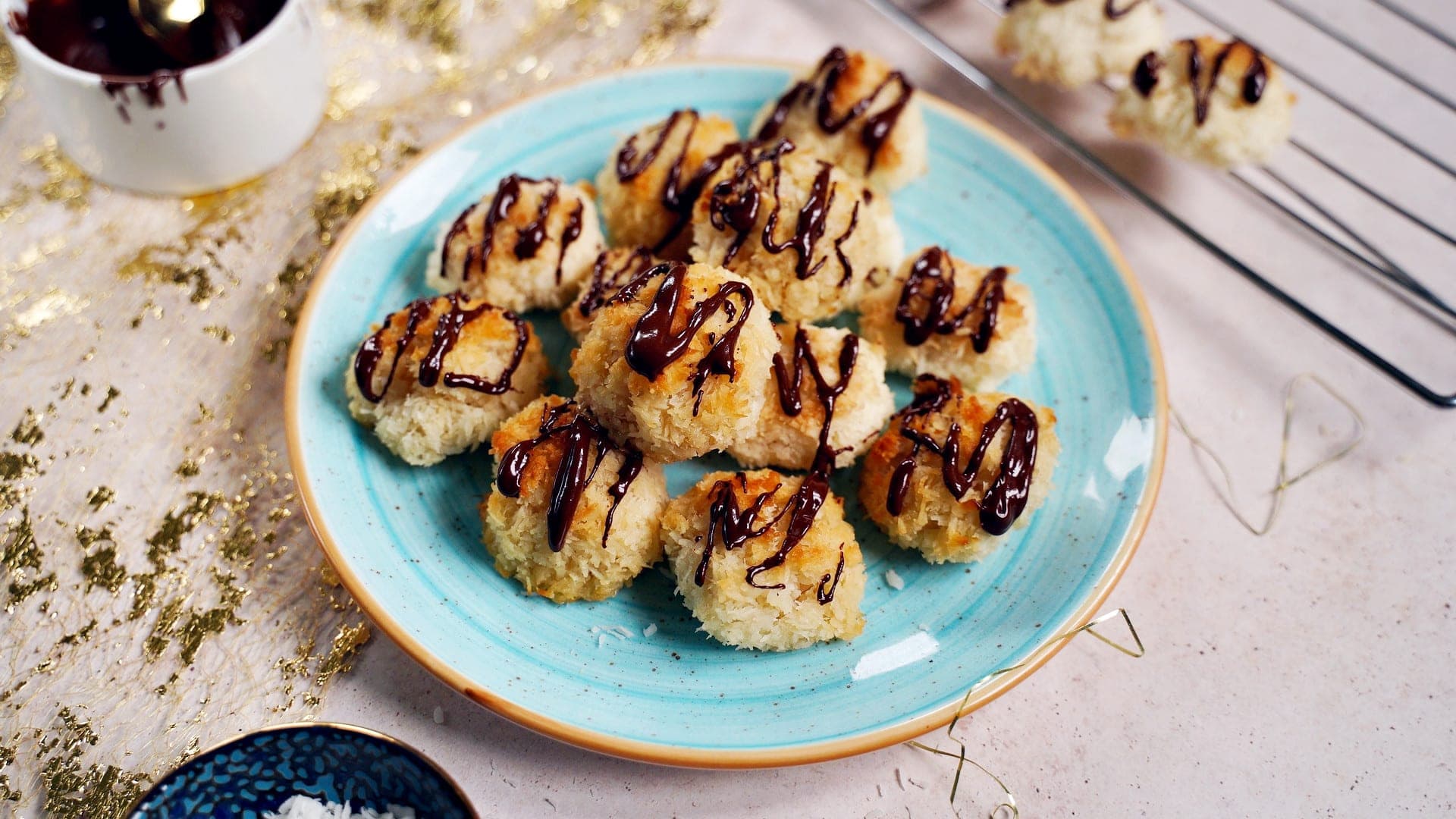
How to Store?
Store: Once cooled, store the egg-free macaroons covered at room temperature for 3-5 days or in a container in the fridge for 7-10 days.
They will be their most crisp on the first day when baked and tend to become more tender over time. Enjoy them chilled or at room temperature.
Freeze: You can either flash freeze or transfer the vegan macaroons to an airtight container with parchment paper between the layers. Store in the freezer for up to 3 months. Allow them to thaw on the counter for several minutes when you want one.
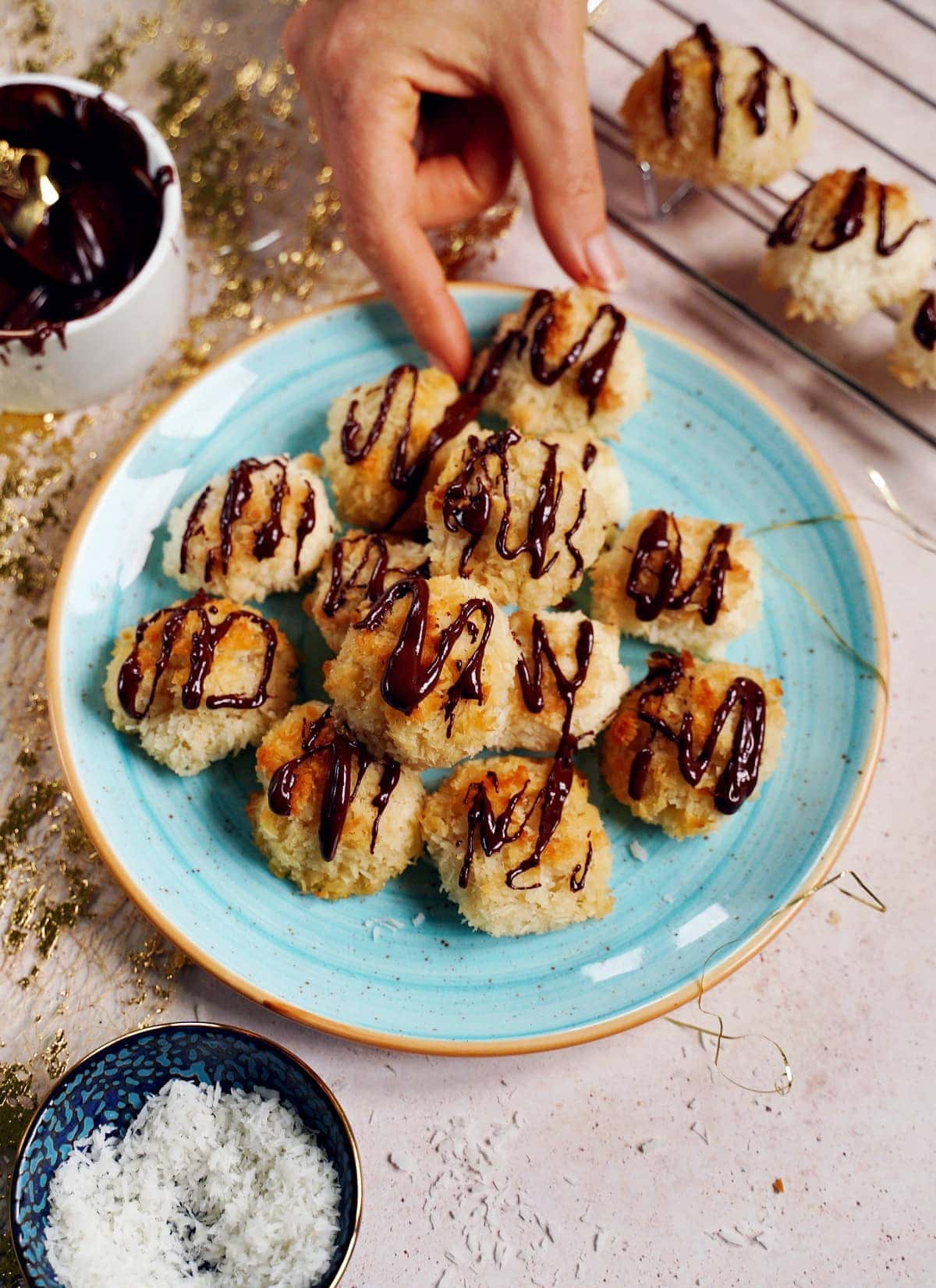
FAQs
Are traditional macaroons vegan?
Not usually, as the ingredients include egg whites and condensed milk. However, this version is 100% vegan and plant-based!
Are coconut macaroons bad for you?
Traditionally, coconut macaroons contain high levels of refined sugars and fats. However, in comparison, this vegan macaroons’ recipe contains less sugar, less fat, and can even be made sugar-free and therefore keto!
Are macaroons and macarons the same?
There seems to be some confusion here, as French macarons are also sometimes referred to as French macaroons. However, macaroons and macarons are entirely different.
Coconut macaroons are a soft and sweet shredded coconut-based cookie with lots of texture and chew (and easy to make!). In comparison, macarons (which are fairly tricky to get right) are made with a fine almond flour and egg-white base. The result are nutty meringue-based sandwich cookies that are then stuffed with various fillings (ganache, buttercream, jam, curd, etc.)
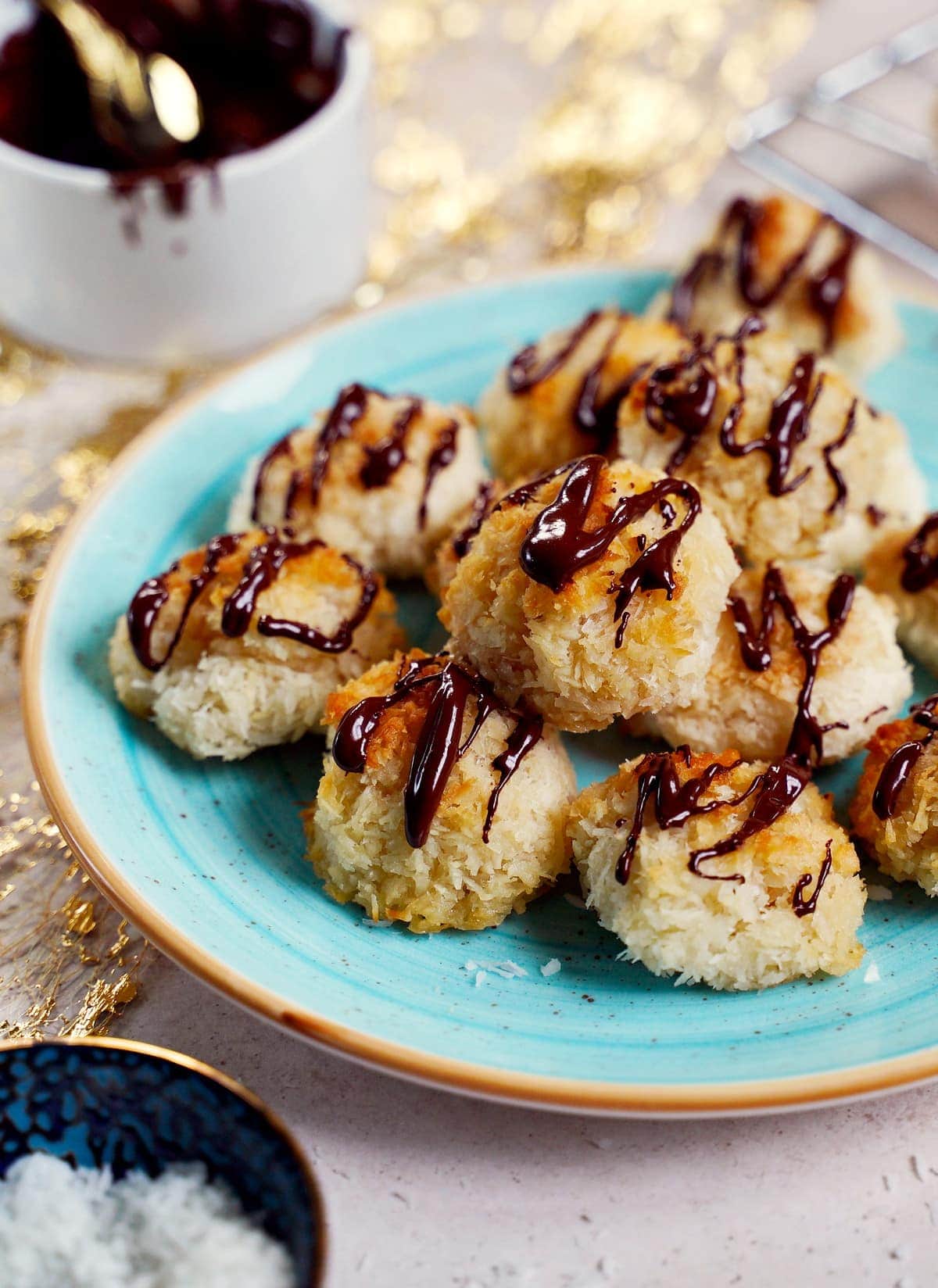
Recipe Notes and Top Tips
- The correct dough consistency: The aquafaba macaroon dough must be wet but scoopable. If it’s too dry, the macaroons will fall apart (likewise, if it’s too wet, they’ll not hold their shape). Adjust the amount of coconut if needed.
- Adjust the baking time: Based on the exact size of the vegan macaroons. Be careful not to overbake the coconut cookies, or they’ll dry out.
- Don’t add too many optional mix-ins: Otherwise, they can fall apart.
- For slightly more toasted coconut: You can toast the shredded coconut lightly, but it’s important to only do so until lightly golden; otherwise, the coconut may burn in the oven. You can do this either in a dry skillet or in the oven (350F/175C).
More Vegan Cookie Recipes
- Cinnamon Star Cookies (Zimtsterne)
- Almond Thumbprint Cookies,
- Vegan Snickerdoodles
- German Hazelnut Cookies
- Vegan Gingerbread Cookies
- Soft Coconut Sugar Cookies
- Double Chocolate Chip Fudge Cookies
If you try this easy vegan coconut macaroons recipe, I’d love a comment and ★★★★★ recipe rating below. Also, please don’t forget to tag me in re-creations on Instagram or Facebook with @elavegan #elavegan—I love seeing them.
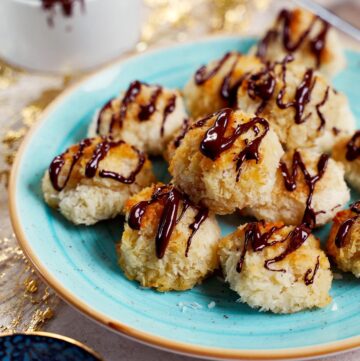
Vegan Coconut Macaroons
Ingredients
- 1 (15 oz) can of chickpeas no salt added (you will need the liquid)
- 1/4 tsp cream of tartar
- 1 tsp lime juice or lemon juice
- 1 tsp tapioca flour
- 3/4 cup (100 g) powdered Erythritol or icing sugar
- 1 2/3 cups (150 g) shredded unsweetened coconut
- Melted vegan chocolate (optional)
Instructions
- You can watch the video in the post for visual instructions.Drain the complete liquid of one can of chickpeas into a saucepan (save the chickpeas for a meal) and let the liquid simmer for about 5 minutes. You will need 100 ml (3.53 oz) of the liquid (called aquafaba). Let it cool, preferably in the fridge or freezer, for about 20 minutes.
- Once cooled, transfer it to a medium-sized bowl along with the cream of tartar and lime juice. Using an electric hand mixer (or a Kitchen aid) whip it for 3-4 minutes.
- Then pause and add the tapioca flour. Whip for a further 3-4 minutes until you see stiff peaks forming.
- At this point, start adding the powdered Erythritol (or icing sugar), 1 tablespoon at a time, while you continue to whip the aquafaba. After you added all of it, the whipped aquafaba should be glossy and stiff, and able to be turned upside down without falling.It's basically impossible to over whip the aquafaba, so do it for as long as needed. 10-15 minutes is usually enough, though.
- Preheat the oven to 300 degrees F (150 C) and line a large baking sheet with parchment paper.
- Start adding the shredded unsweetened coconut to the bowl, 1 tablespoon at a time. Using a spatula, fold it into the whipped aquafaba. Be gentle and avoid beating out the added air.The dough should be wet but scoopable. If it's too dry, the macaroons will fall apart (likewise, if it's too wet, they'll not hold their shape). Adjust the amount of coconut if needed.
- Using heaped teaspoons (or a level tablespoon/ cookie scoop), transfer the mixture to the prepared baking tray, with a bit of space between each one.
- Bake in the oven for about 30 minutes until the top and edges start turning golden. Let them cool completely for at least 10-15 minutes, as they will be quite fragile and only firm up once cooled.
- Drizzle with some melted chocolate (this step is optional) and enjoy!
Notes
- Check the blog post for substitutes, optional add-ins, and storing instructions.
Nutrition information is an estimate and has been calculated automatically
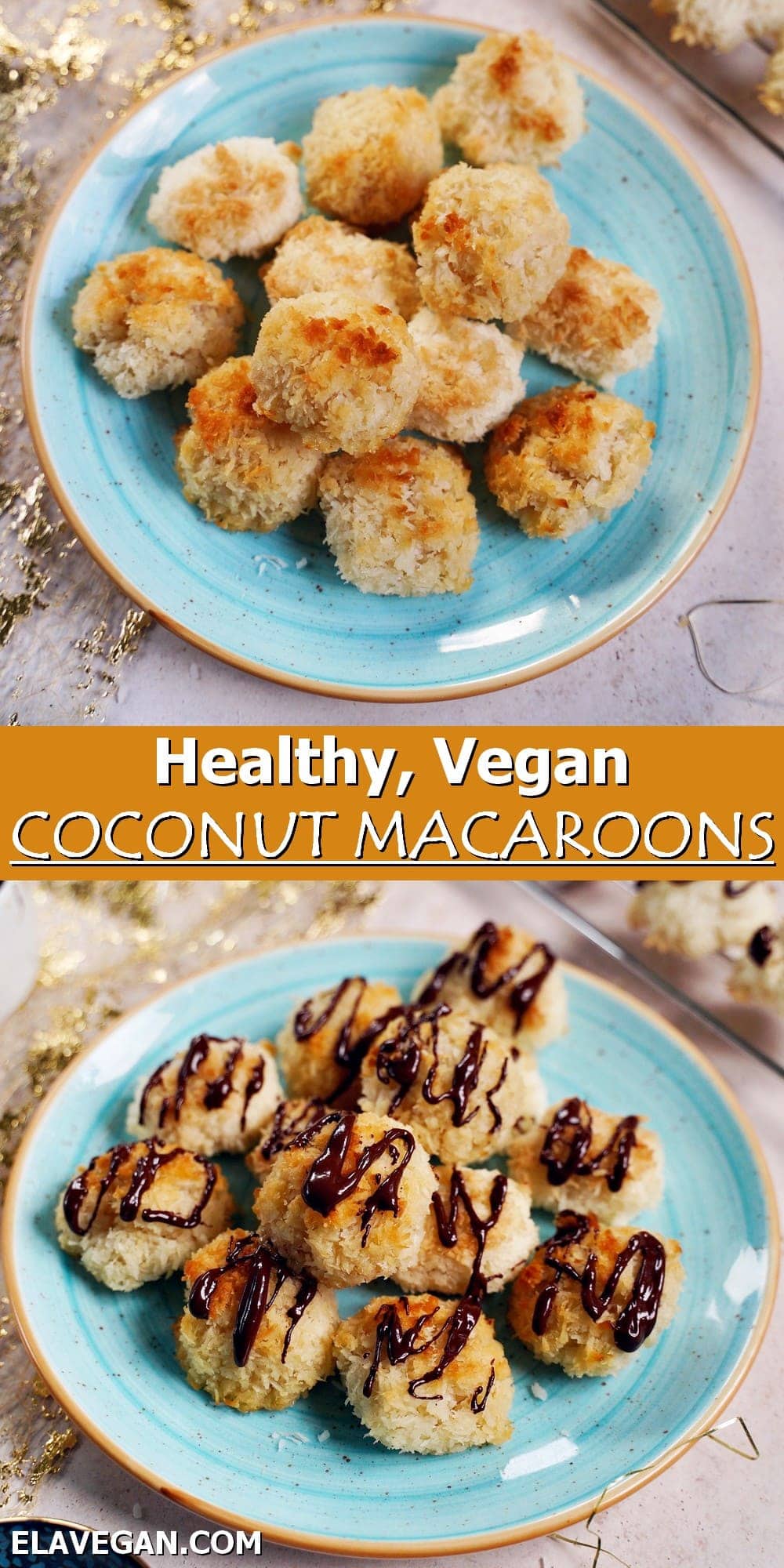

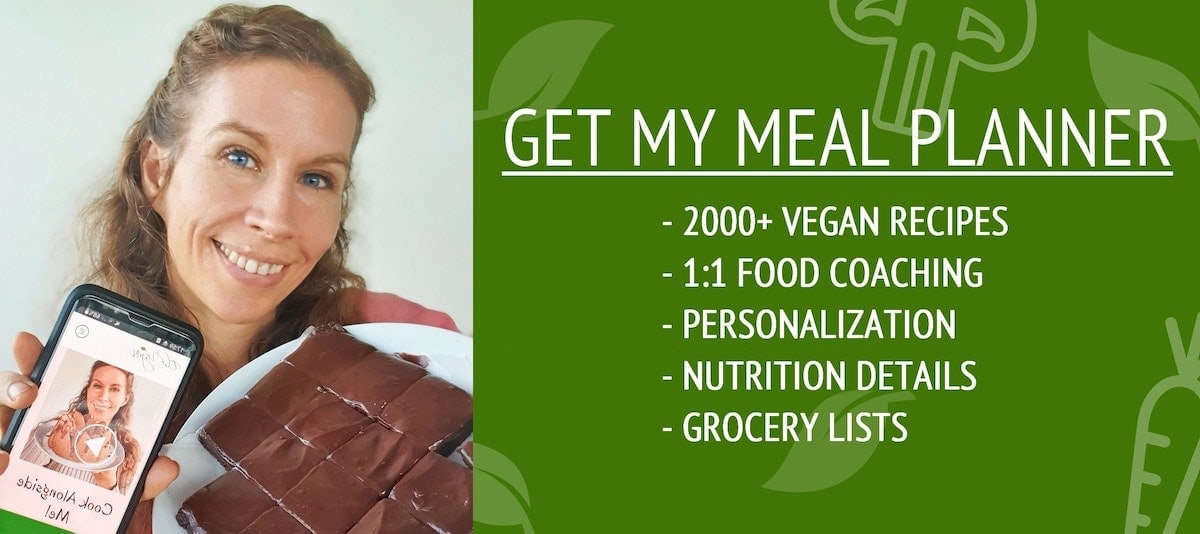

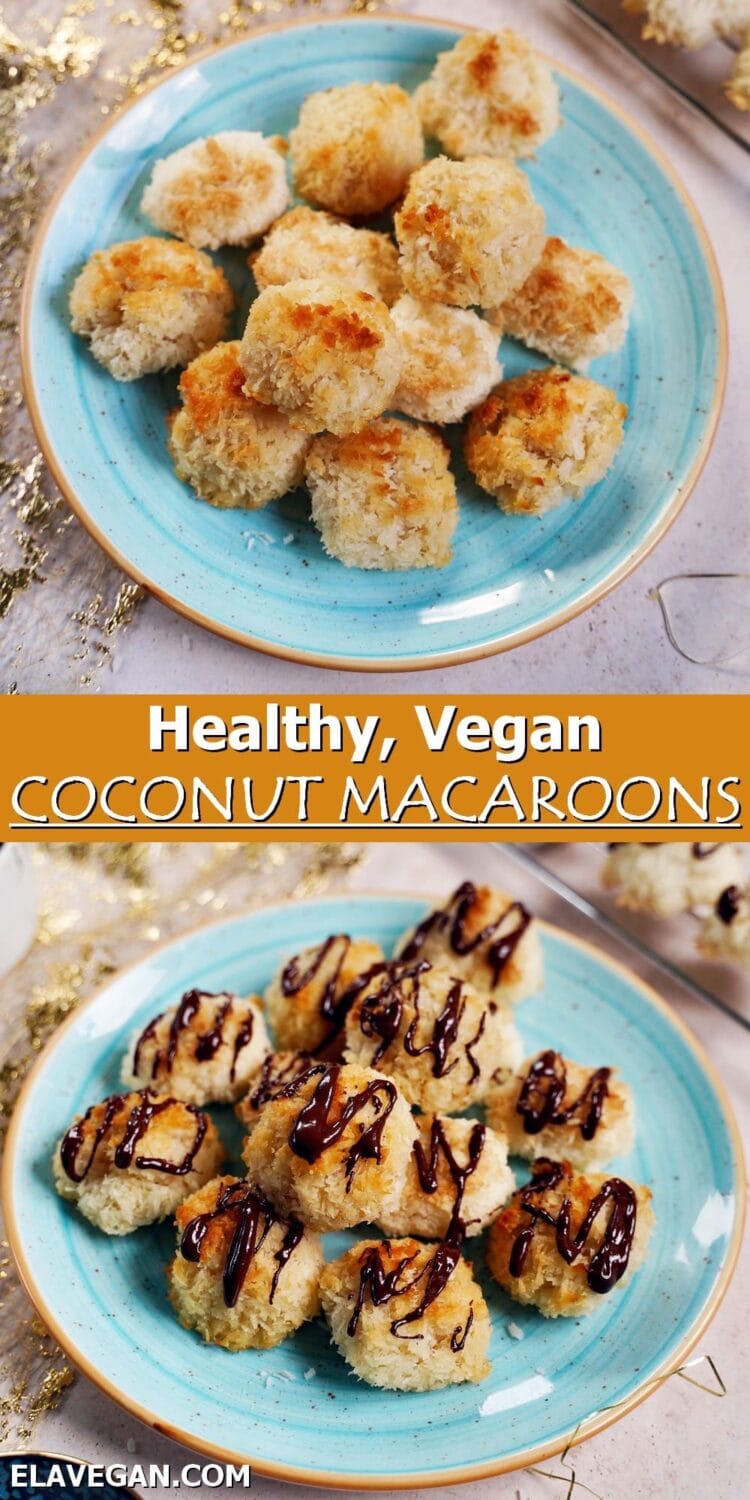
Hi I’/m looking forward to trying these but it might be better to stick with sugar as there a re risks associated with erythritol
https://www.webmd.com/diet/what-is-erythritol
Hi Ela! Looks delicious!!! But I can’t find tapioca flour where I live. Any idea with what can I replace it?
Thanks for everything you do ????????
Ah, my bad, I read the whole description and saw that I can replace it with cornstarch..I will try it this way then. Also, what is exactly cream of tartar? Can I find it like that in the shop? Thanks again!
Hi Nadine, don’t worry! Yes, cornstarch should work.
Cream of tartar is quite acidic, and it makes the whipped aquafaba more stable. You might just use a little more lime juice (e.g. 1/2 tsp more). 🙂
Hi Ela. Where is the high saturated fat coming from ?
Hi Jenny! From the coconut. 🙂